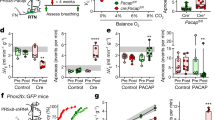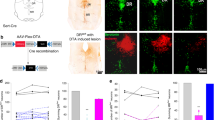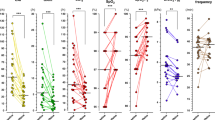Abstract
Background
Leptin augments central CO2 chemosensitivity and stabilizes breathing in adults. Premature infants have unstable breathing and low leptin levels. Leptin receptors are on CO2 sensitive neurons in the Nucleus Tractus Solitarius (NTS) and locus coeruleus (LC). We hypothesized that exogenous leptin improves hypercapnic respiratory response in newborn rats by improving central CO2 chemosensitivity.
Methods
In rats at postnatal day (p)4 and p21, hyperoxic and hypercapnic ventilatory responses, and pSTAT and SOCS3 protein expression in the hypothalamus, NTS and LC were measured before and after treatment with exogenous leptin (6 µg/g).
Results
Exogenous leptin increased the hypercapnic response in p21 but not in p4 rats (P ≤ 0.001). At p4, leptin increased pSTAT expression only in the LC, and SOCS3 expression in the NTS and LC; while at p21 pSTAT and SOCS3 levels were higher in the hypothalamus, NTS, and LC (P ≤ 0.05).
Conclusions
We describe the developmental profile of the effect of exogenous leptin on CO2 chemosensitivity. Exogenous leptin does not augment central CO2 sensitivity during the first week of life in newborn rats. The translational implication of these findings is that low plasma leptin levels in premature infants may not be contributing to respiratory instability.
Impact
-
Exogenous leptin does not augment CO2 sensitivity during the first week of life in newborn rats, similar to the developmental period when feeding behavior is resistant to leptin.
-
Exogenous leptin increases CO2 chemosensitivity in newborn rats after the 3rd week of life and upregulates the expression of pSTAT and SOC3 in the hypothalamus, NTS and LC.
-
Low plasma leptin levels in premature infants are unlikely contributors to respiratory instability via decreased CO2 sensitivity in premature infants. Thus, it is highly unlikely that exogenous leptin would alter this response.
This is a preview of subscription content, access via your institution
Access options
Subscribe to this journal
Receive 14 print issues and online access
$259.00 per year
only $18.50 per issue
Buy this article
- Purchase on Springer Link
- Instant access to full article PDF
Prices may be subject to local taxes which are calculated during checkout





Similar content being viewed by others
Data availability
All data generated and analyzed have been included in this article and Supplementary materials.
References
Di Fiore, J. M., Martin, R. J. & Gauda, E. B. Apnea of prematurity-perfect storm. Respir. Physiol. Neurobiol. 189, 213–222 (2013).
Gauda, E. B. & Master, Z. Contribution of relative leptin and adiponectin deficiencies in premature infants to chronic intermittent hypoxia: Exploring a new hypothesis. Respir. Physiol. Neurobiol. 256, 119–127 (2018).
Darnall, R. A. The role of CO(2) and central chemoreception in the control of breathing in the fetus and the neonate. Respir. Physiol. Neurobiol. 173, 201–212 (2010).
Al-Saif, S. et al. A randomized controlled trial of theophylline versus CO2 inhalation for treating apnea of prematurity. J. Pediatr. 153, 513–518 (2008).
Martin, R. J., Wang, K., Köroğlu, O., Di Fiore, J. & Kc, P. Intermittent hypoxic episodes in preterm infants: do they matter? Neonatology 100, 303–310 (2011).
Savich, R. D., Guerra, F. A., Lee, C. C. & Kitterman, J. A. Prostaglandin E2 decreases fetal breathing movements, but not pulmonary blood flow, in fetal sheep. J. Appl. Physiol. 78, 1477–1484 (1995).
Masuzaki, H. et al. Nonadipose tissue production of leptin: leptin as a novel placenta-derived hormone in humans. Nat. Med. 3, 1029–1033 (1997).
Rajala, M. W. & Scherer, P. E. Minireview: The adipocyte-at the crossroads of energy homeostasis, inflammation, and atherosclerosis. Endocrinology 144, 3765–3773 (2003).
Münzberg, H. & Morrison, C. D. Structure, production and signaling of leptin. Metab. Clin. Exp. 64, 13–23 (2015).
Inyushkin, A. N., Inyushkina, E. M. & Merkulova, N. A. Respiratory responses to microinjections of leptin into the solitary tract nucleus. Neurosci. Behav. Physiol. 39, 231–240 (2009).
Kerem, N. C. et al. Respiratory functions in adolescents hospitalized for anorexia nervosa: a prospective study. Int. J. Eat. Disord. 45, 415–422 (2012).
Phipps, P. R., Starritt, E., Caterson, I. & Grunstein, R. R. Association of serum leptin with hypoventilation in human obesity. Thorax 57, 75–76 (2002).
Delahaye, F. et al. Maternal perinatal undernutrition drastically reduces postnatal leptin surge and affects the development of arcuate nucleus proopiomelanocortin neurons in neonatal male rat pups. Endocrinology 149, 470–475 (2008).
Guyenet, P. G., Stornetta, R. L. & Bayliss, D. A. Central respiratory chemoreception. J. Comp. Neurol. 518, 3883–3906 (2010).
Caron, E., Sachot, C., Prevot, V. & Bouret, S. G. Distribution of leptin-sensitive cells in the postnatal and adult mouse brain. J. Comp. Neurol. 518, 459–476 (2010).
Bjørbaek, C., Elmquist, J. K., Frantz, J. D., Shoelson, S. E. & Flier, J. S. Identification of SOCS-3 as a potential mediator of central leptin resistance. Mol. Cell 1, 619–625 (1998).
Münzberg, H., Huo, L., Nillni, E. A., Hollenberg, A. N. & Bjørbaek, C. Role of signal transducer and activator of transcription 3 in regulation of hypothalamic proopiomelanocortin gene expression by leptin. Endocrinology 144, 2121–2131 (2003).
Kinkead, R., Dupenloup, L., Valois, N. & Gulemetova, R. Stress-induced attenuation of the hypercapnic ventilatory response in awake rats. J. Appl. Physiol. 90, 1729–1735 (2001).
Mendelson, W. B. et al. Periodic cessation of respiratory effort during sleep in adult rats. Physiol. Behav. 43, 229–234 (1988).
Lopes, L. T. et al. Anatomical and functional connections between the locus coeruleus and the nucleus tractus solitarius in neonatal rats. Neuroscience 324, 446–468 (2016).
Ivanovska, J. et al. Recombinant adiponectin protects the newborn rat lung from lipopolysaccharide-induced inflammatory injury. Physiol. Rep. 8, e14553 (2020).
Jankov, R. P. et al. A role for platelet-derived growth factor beta-receptor in a newborn rat model of endothelin-mediated pulmonary vascular remodeling. Am. J. Physiol. Lung Cell Mol. Physiol. 288, L1162–L1170 (2005).
Inyushkina, E. M., Merkulova, N. A. & Inyushkin, A. N. Mechanisms of the respiratory activity of leptin at the level of the solitary tract nucleus. Neurosci. Behav. Physiol. 40, 707–713 (2010).
Laque, A. et al. Leptin receptor neurons in the mouse hypothalamus are colocalized with the neuropeptide galanin and mediate anorexigenic leptin action. Am. J. Physiol. Endocrinol. Metab. 304, E999–E1011 (2013).
Gauda, E. B., Carroll, J. L. & Donnelly, D. F. Developmental maturation of chemosensitivity to hypoxia of peripheral arterial chemoreceptors-invited article. Adv. Exp. Med. Biol. 648, 243–255 (2009).
Williams, B. A. et al. Development of respiratory chemoreflexes in response to alternations of fractional inspired oxygen in the newborn infant. J. Physiol. (Lond.) 442, 81–90 (1991).
Gauda, E. B. & Lawson, E. E. Developmental influences on carotid body responses to hypoxia. Respir. Physiol. 121, 199–208 (2000).
Liu, Q., Lowry, T. F. & Wong-Riley, M. T. T. Postnatal changes in ventilation during normoxia and acute hypoxia in the rat: implication for a sensitive period. J. Physiol. (Lond.) 577, 957–970 (2006).
Al-Matary, A. et al. Increased peripheral chemoreceptor activity may be critical in destabilizing breathing in neonates. Semin. Perinatol. 28, 264–272 (2004).
Cardot, V. et al. Ventilatory response to a hyperoxic test is related to the frequency of short apneic episodes in late preterm neonates. Pediatr. Res. 62, 591–596 (2007).
Porzionato, A. et al. Expression of leptin and leptin receptor isoforms in the rat and human carotid body. Brain Res. 1385, 56–67 (2011).
Caballero-Eraso, C. et al. Leptin acts in the carotid bodies to increase minute ventilation during wakefulness and sleep and augment the hypoxic ventilatory response. J. Physiol. (Lond.) 597, 151–172 (2019).
Deacon-Diaz, N. & Malhotra, A. Inherent vs. induced loop gain abnormalities in obstructive sleep apnea. Front. Neurol. 9, 896 (2018).
Putnam, R. W., Conrad, S. C., Gdovin, M. J., Erlichman, J. S. & Leiter, J. C. Neonatal maturation of the hypercapnic ventilatory response and central neural CO2 chemosensitivity. Respir. Physiol. Neurobiol. 149, 165–179 (2005).
Bouret, S. G., Bates, S. H., Chen, S., Myers, M. G. & Simerly, R. B. Distinct roles for specific leptin receptor signals in the development of hypothalamic feeding circuits. J. Neurosci. 32, 1244–1252 (2012).
Cottrell, E. C. et al. Developmental changes in hypothalamic leptin receptor: relationship with the postnatal leptin surge and energy balance neuropeptides in the postnatal rat. Am. J. Physiol. Regul. Integr. Comp. Physiol. 296, R631–R639 (2009).
Ertl, T. et al. Postnatal changes of leptin levels in full-term and preterm neonates: their relation to intrauterine growth, gender and testosterone. Biol. Neonate 75, 167–176 (1999).
Stoll-Becker, S. et al. Influence of gestational age and intrauterine growth on leptin concentrations in venous cord blood of human newborns. Klin. Padiatr. 215, 3–8 (2003).
Attig, L. et al. Postnatal leptin promotes organ maturation and development in IUGR piglets. PLoS One 8, e64616 (2013).
Attig, L., Larcher, T., Gertler, A., Abdennebi-Najar, L. & Djiane, J. Postnatal leptin is necessary for maturation of numerous organs in newborn rats. Organogenesis 7, 88–94 (2011).
Ahima, R. S. & Hileman, S. M. Postnatal regulation of hypothalamic neuropeptide expression by leptin: implications for energy balance and body weight regulation. Regul. Pept. 92, 1–7 (2000).
Mistry, A. M., Swick, A. & Romsos, D. R. Leptin alters metabolic rates before acquisition of its anorectic effect in developing neonatal mice. Am. J. Physiol. 277, R742–R747 (1999).
Pan, W., Hsuchou, H., Tu, H. & Kastin, A. J. Developmental changes of leptin receptors in cerebral microvessels: unexpected relation to leptin transport. Endocrinology 149, 877–885 (2008).
Abdennebi-Najar, L. et al. Basal, endogenous leptin is metabolically active in newborn rat pups. J. Matern. Fetal Neonatal Med. 24, 1486–1491 (2011).
Pho, H. et al. Leptin receptor expression in the dorsomedial hypothalamus stimulates breathing during NREM sleep in db/db mice. Sleep 44, zsab046 (2021).
Smith, J. T., Mark, P. J. & Waddell, B. J. Developmental increases in plasma leptin binding activity and tissue Ob-Re mRNA expression in the rat. J. Endocrinol. 184, 535–541 (2005).
Cottrell, E. C., Mercer, J. G. & Ozanne, S. E. Postnatal development of hypothalamic leptin receptors. Vitam. Horm. 82, 201–217 (2010).
Ciriello, J. & Moreau, J. M. Systemic administration of leptin potentiates the response of neurons in the nucleus of the solitary tract to chemoreceptor activation in the rat. Neuroscience 229, 88–99 (2013).
Bassi, M. et al. Central leptin replacement enhances chemorespiratory responses in leptin-deficient mice independent of changes in body weight. Pflug. Arch. 464, 145–153 (2012).
Carlo, A. S. et al. Leptin sensitivity in the developing rat hypothalamus. Endocrinology 148, 6073–6082 (2007).
Acknowledgements
Dr. Gauda would like to thank Dr. Seva Polotsky for the use of the whole-body plethysmograph in his laboratory and Ariel Mason for performing the pilot experiment that was done at Johns Hopkins in 2016, and Ms. Sonia Dos Santos for proof-reading the final draft.
Funding
Supported by the Women’s Auxiliary Chair in Neonatology at The Hospital for Sick Children.
Author information
Authors and Affiliations
Contributions
L.T.-H.; E.B.G., J.B., G.M.: Substantial contributions to conception and design, acquisition of data, analysis and interpretation of data. Drafting the article or revising it critically for important intellectual content and final approval of the version to be published. R.P., E.P., J.I.: Substantial contributions to conception and design, acquisition of data, or analysis and interpretation of data. H.W., G.B., A.P., N.I.: Substantial contributions to acquisition and analysis of data.
Corresponding author
Ethics declarations
Competing interests
The authors declare no competing interests.
Additional information
Publisher’s note Springer Nature remains neutral with regard to jurisdictional claims in published maps and institutional affiliations.
Supplementary information
Rights and permissions
Springer Nature or its licensor (e.g. a society or other partner) holds exclusive rights to this article under a publishing agreement with the author(s) or other rightsholder(s); author self-archiving of the accepted manuscript version of this article is solely governed by the terms of such publishing agreement and applicable law.
About this article
Cite this article
Tamir-Hostovsky, L., Ivanovska, J., Parajón, E. et al. Maturational effect of leptin on CO2 chemosensitivity in newborn rats. Pediatr Res 94, 971–978 (2023). https://doi.org/10.1038/s41390-023-02604-3
Received:
Revised:
Accepted:
Published:
Issue Date:
DOI: https://doi.org/10.1038/s41390-023-02604-3



